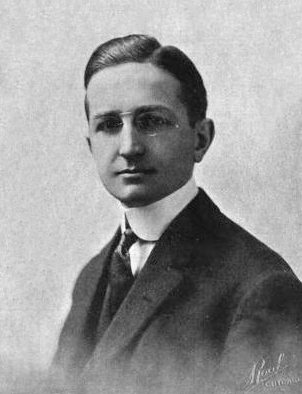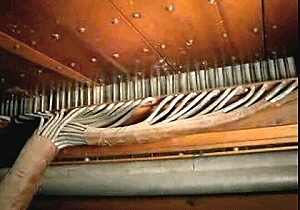
A harpsichord is a musical instrument played by means of a keyboard. This activates a row of levers that turn a trigger mechanism that plucks one or more strings with a small plectrum made from quill or plastic. The strings are under tension on a soundboard, which is mounted in a wooden case; the soundboard amplifies the vibrations from the strings so that the listeners can hear it. Like a pipe organ, a harpsichord may have more than one keyboard manual, and even a pedal board. Harpsichords may also have stop buttons which add or remove additional octaves. Some harpsichords may have a buff stop, which brings a strip of buff leather or other material in contact with the strings, muting their sound to simulate the sound of a plucked lute.

The pipe organ is a musical instrument that produces sound by driving pressurised air through the organ pipes selected from a keyboard. Because each pipe produces a single pitch, the pipes are provided in sets called ranks, each of which has a common timbre, volume, and construction throughout the keyboard compass. Most organs have many ranks of pipes of differing pitch, timbre, and volume that the player can employ singly or in combination through the use of controls called stops.

In music, the organ is a keyboard instrument of one or more pipe divisions or other means for producing tones. The organs have usually two or three, up to five, manuals for playing with the hands and a pedalboard for playing with the feet. With the use of registers, several groups of pipes can be connected to one manual.

An electric organ, also known as electronic organ, is an electronic keyboard instrument which was derived from the harmonium, pipe organ and theatre organ. Originally designed to imitate their sound, or orchestral sounds, it has since developed into several types of instruments:

A pedalboard is a keyboard played with the feet that is usually used to produce the low-pitched bass line of a piece of music. A pedalboard has long, narrow lever-style keys laid out in the same semitone scalar pattern as a manual keyboard, with longer keys for C, D, E, F, G, A, and B, and shorter, raised keys for C♯, D♯, F♯, G♯ and A♯. Training in pedal technique is part of standard organ pedagogy in church music and art music.

A theatre organ is a type of pipe organ developed to accompany silent films, from the 1900s to the 1920s.

Ernest Martin Skinner was an American pipe organ builder. His electro-pneumatic switching systems advanced the technology of organ building in the first part of the 20th century.

A manual is a musical keyboard designed to be played with the hands, on an instrument such as a pipe organ, harpsichord, clavichord, electronic organ, melodica, or synthesizer. The term "manual" is used with regard to any hand keyboard on these instruments to distinguish it from the pedalboard, which is a keyboard that the organist plays with their feet. It is proper to use "manual" rather than "keyboard", then, when referring to the hand keyboards on any instrument that has a pedalboard.

Bass pedals are an electronic musical instrument with a foot-operated pedal keyboard with a range of one or more octaves. The earliest bass pedals from the 1970s consisted of a pedalboard and analog synthesizer tone generation circuitry packaged together as a unit. The bass pedals are plugged into a bass amplifier or PA system so that their sound can be heard. Since the 1990s, bass pedals are usually MIDI controllers, which have to be connected to a MIDI-compatible computer, electronic synthesizer keyboard, or synth module to produce musical tones. Some 2010s-era bass pedals have both an onboard synth module and a MIDI output.

Tracker action is a term used in reference to pipe organs and steam calliopes to indicate a mechanical linkage between keys or pedals pressed by the organist and the valve that allows air to flow into pipe(s) of the corresponding note. This is in contrast to "direct electric action" and "electro-pneumatic action", which connect the key to the valve through an electrical link or an electrically assisted pneumatic system respectively, or "tubular-pneumatic action" which utilizes a change of pressure within lead tubing which connects the key to the valve pneumatic.

An expression pedal is an important control found on many musical instruments including organs, electronic keyboards, and pedal steel guitar. The musician uses the pedal to control different aspects of the sound, commonly volume. Separate expression pedals can often be added to a guitar amplifier or effects unit and used to control many different aspects of the tone.

The pedal piano is a kind of piano that includes a pedalboard, enabling bass register notes to be played with the feet, as is standard on the organ.

Piano pedals are foot-operated levers at the base of a piano that change the instrument's sound in various ways. Modern pianos usually have three pedals, from left to right, the soft pedal, the sostenuto pedal, and the sustaining pedal. Some pianos omit the sostenuto pedal, or have a middle pedal with a different purpose such as a muting function also known as silent piano.

Henry Willis, also known as "Father" Willis, was an English organ player and builder, who is regarded as the foremost organ builder of the Victorian era. His company Henry Willis & Sons remains in business.

The pipe organ is played from an area called the console or keydesk, which holds the manuals (keyboards), pedals, and stop controls. In electric-action organs, the console is often movable. This allows for greater flexibility in placement of the console for various activities. Some very large organs, such as the van den Heuvel organ at the Church of St. Eustache in Paris, have more than one console, enabling the organ to be played from several locations depending on the nature of the performance.
Registration is the technique of choosing and combining the stops of a pipe organ in order to produce a particular sound. Registration can also refer to a particular combination of stops, which may be recalled through combination action. The registration chosen for a particular piece will be determined by a number of factors, including the composer's indications, the time and place in which the piece was composed, the organ the piece is played upon, and the acoustic environment within which the organ resides.

"Tubular-pneumatic action" refers to an apparatus used in many pipe organs built during the late 19th and early 20th centuries. The term "tubular" refers to the extensive use of lead tubing to connect the organ's console to the valves that control the delivery of "wind" to the organ's pipes. Many such organs are extant 100 or more years after their construction.
RIHA Adagio is a Dutch electronic organ with a built-in Leslie speaker and a fine wood finish. Similar to other RIHA organs, the Adagio was made by Benelux Musical Instruments, The Hague, the Netherlands. A fine member of those line of all-transistor Dutch organs that featured eight models in three console finishes - walnut, teak, and rosewood. All of them have standard features, including, but not limited to, pedal volume control, brilliance control, and reverberation. The Adagio is one of the once popular RIHA models, along with the Festivo, the Andante, and the Allegro.

A residence organ is a musical organ installed in a personal home. Strictly speaking, the names residence and house organ are the most correct, the others being types of organs that can physically be used as residence organs, but that are not restricted to use solely in that context, and can also be used in, say, small churches, theatres, and so forth. A portative organ or a positive organ can be used in a residential setting, but the notion of a residence organ strictly embodies a permanence of place that is belied by the notion of portability embodied by the portatives and positives. Similarly, a chamber organ is in general a small organ for a room, but not necessarily for a room of someone's home.

Casavant Frères Ltée. Opus 1841 is a pipe organ built by the famous Casavant Frères of Saint-Hyacinthe, Quebec. The organ was first completed in 1911 as Casavant Brothers - Opus 452 for St. Andrew's Presbyterian Church at 40 Bentinck Street, Sydney, Nova Scotia, Canada. St. Andrew's later became St. Andrew's United Church and is now the Highland Arts Theatre.

















